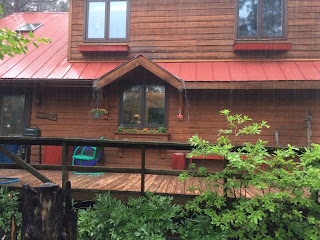Baltimore Orioles
WINGIN’
IT
By
Kate Crowley
When you see a
Baltimore oriole, there is no doubt this bird comes from the tropics. But you
may be surprised to learn that this beauty is from the same family of birds as
grackles, red-winged blackbirds and meadowlarks. In coloration and nest type it more resembles
the Old World Orioles, but genetically, they are not closely related.
Each spring when we see
the first Baltimore oriole in our yard, we rush madly for oranges and fruit
jelly (grape being the preferred). Then
we quickly slice the oranges and dash outside with it and the jar of jelly to
entice the beautiful orange and black birds to stick around. For awhile we even
had a special plastic oriole feeder that looked like (sort of) a large
orange. This we filled with sugar water.
But even this failed to convince the birds to stay. Inevitably we went out the next day to
collect the orange which was starting to shrivel and the jelly coagulating into
a solid mass. With undimmed hope, we
repeated the ritual on May 14th this year, only this time we saw
both the male and female orioles, and they went straight to the oranges!
The real test was the
next day when we saw them again. We
could hardly believe our eyes. We
replenished the oranges as the interiors were consumed. The birds poke their
beaks into the exposed segments and with their brush covered tongues they
collect the juice. Day three and they
were still coming for oranges and jelly!
We almost feared suggesting it, but maybe this year the pair would find
a good nesting spot somewhere in our trees.
Baltimore orioles spend
the winters in Central America and then move in huge numbers to North America
in early April and late May. They are
only found east of the Mississippi River, but all the way from the Gulf Coast
up into Canada. They will nest in all of
these states.
We know the orioles
have nested in the surrounding area, but for whatever reason our place has
never met with their approval. They require
fairly specific trees for their nests, preferring tall deciduous species like
cottonwoods, maples and American elms.
We have some maples on our property, but most are back in the woods and
the orioles prefer a more open space or near the edge of the woods. Some years ago we planted two maples in our front
yard and the silver has grown very tall, perfect in our opinion, for an oriole
nest. Oh, how we would love to find a tightly
woven tube of fibers swaying from an upper branch come fall.
The female chooses the
nest site within the male’s territory. We have only seen the one pair, so it
would seem she could start picking out the best spot any time now. The upper most branches of a tall tree are
those normally chosen. The female starts
the process by draping long strips of fiber, which can include grass, strips of
grapevine bark, and horsehair, as well as any other found items like
cellophane, twine, or fishing line. If available they will recycle fibers from
an old nest to build a new one.
I received a bunch of
shed horsehair from a friend this spring, specifically to put out for the
birds. I have watched chickadees come to
the onion bag that I put it in and pluck out a beak-full, and I hope the female
oriole saw this handy nest material and added that to her list of pluses for
this location.
Once a collection of
fibers have been hung on the branch, the female will begin to poke her beak
into it over and over, inadvertently creating knots and weaving the fibers
together. Nest building is a three part
process. First there is the outer shape
which must be flexible and provide support. Next the inner bowl is woven with
springy fibers. This helps maintain the
bag-like shape of the nest. Finally, she adds feathers and downy feathers to
cushion the eggs and young. An entry
hole is created near the top of the nest, two to three inches wide.
Once the eggs hatch the
parents will focus more of their food gathering on insects. The birds will
search in and around trees and shrubs, flying out when necessary to grab
beetles, crickets, grasshoppers, moths, and flies, and pest species like tent
caterpillars, gypsy moth caterpillars and larvae within plant galls. Besides
being beautiful, these are very useful birds to have around. The flip side is that they still love fruits
and nectar and will covet and consume your raspberries and other juicy, dark
colored fruits, given the chance.
If you have a pair (or
more) of orioles nesting nearby, count yourself lucky. They will add flashes of color and sweet song
all summer long.



Comments
Post a Comment